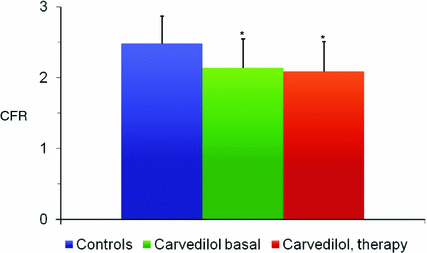Fig. 9.1
Panel a. Myocardial efficiency at baseline and 6 months (follow-up) after alcohol septal ablation in patients with HCM. Panel b. Linear relationship between the changes (baseline vs. 6 months after alcool septal ablation) in coronary vasodilator reserve (CVR) and those in LV mass. Dotted lines represent the 95 % confidence interval of the regression line. Adapted from Timmer SA et al. [3]
In contrast, verapamil administration, which has been reported to have beneficial hemodynamic and symptomatic effects in these patients, failed to show significant improvement of CMD. In one study [4] 15 patients with HCM underwent dipyridamole PET before and 4 weeks after treatment with high-dose verapamil. No significant effects were found on CFR, although an improvement of hyperemic septal endocardial-to-epicardial MBF ratio was observed in some patients. No significant effects by verapamil on both CFR and on hyperemic septal endocardial-to-epicardial MBF ratio were observed, however, in another study [5].
Finally, no effects on CMD were observed in HCM patients with disopyramide [6] or with ACE inhibitors [7].
In contrast, intravenous cibenzoline (1 mg/kg) [8], a class-Ia antiarrhythmic drug, was found to improve CBF response to adenosine triphosphate in 11 patients with obstructive and in 12 patients with nonobstructive HCM. Whether chronic oral therapy with this drug may safely improve CMD, however, remains unknown.
Overall, only alcohol septal ablation seems to be associated with a consistent improvement of CMD in HCM. The implications of these therapeutic results on clinical outcome, however, remain to be established.
9.2 Dilated Cardiomyopathy
Given its favorable effects on clinical outcome, two studies assessed whether carvedilol improves CMD in patients with idiopathic dilated cardiomyopathy.
Calişkan et al. [9] performed dipyridamole TTDE in 24 patients at baseline and after 19 weeks of therapy. Carvedilol reduced LV end-systolic volume and increased LV ejection fraction. No improvement in CFR, however, was observed.
In another study [10], instead, carvedilol was found to increase CFR in patients with idiopathic dilated cardiomyopathy after 6 months of therapy (Fig. 9.2). LV diastolic diameter, LVEF and the diastolic E/A ratio improved after treatment, suggesting a contributory role to improvement of CMD.


Fig. 9.2
Reduced CFR in patients with idiopathic dilated cardiomyopathy (carvedilol basal), compared to controls. Nonsignificant effect on CFR was observed with carvedilol treatment, despite improvement in clinical conditions (carvedilol therapy). *p < 0.05 vs. controls. Data from Calişkan M et al. [9]
Nebivolol also was shown to significantly improve CMD in patients with idiopathic dilated cardiomyopathy [11]. CFR was measured in 21 patients at baseline and 1 month after treatment and was found to increase significantly. No changes in LV end-diastolic diameter and LV stroke volume were observed, although LV end-systolic diameter decreased significantly with treatment.
No significant effects of treatment with verapamil and/or enalapril on CFR, as assessed by dipyridamole PET, were observed in one study [12], despite combined treatment and enalapril alone prevented further deterioration of LV function.
Favorable effects on CMD have instead been reported with treatment with allopurinol [13]. In one study 24 patients with idiopathic dilated cardiomyopathy and high serum uric acid levels were given allopurinol for 3 months. CFR, assessed by TTDE, exhibited a significant improvement; it is believed that the beneficial effect of allopurinol on CMD might be mediated by its anti-oxidant action.
In summary, in patients with dilated cardiomyopathy, beta-blockade seems to have beneficial effects on CMD, likely as a result of improved hemodynamics. Whether allopurinol is a valid form of treatment to this scope in these patients deserves further investigation.
9.3 Aortic Stenosis
As discussed in Chap. 6, the significant reduction of diastolic time of myocardial perfusion plays a significant role in causing the observed reduction of CFR and the appearance of angina in patients with aortic stenosis. Thus, drugs that increase diastolic time, like beta-blockers, might help in delaying the ominous onset of myocardial ischemia and angina in these patients. As an alternative, in case of contraindication or intolerance to beta-blockers, ivabradine, known to selectively reduce heart rate but not blood pressure, might be of help in these patients. These considerations, however, are purely speculative, as clinical studies about the effects of these drugs on coronary microvascular perfusion and on angina and clinical outcome are lacking and should therefore be investigated in prospective randomized trials.
9.4 Myocarditis
While CMD can be present and also play a role in the clinical presentation of acute myocarditis (see Chap. 6), no study has hitherto assessed the effects of any form of intervention on CMD in these patients.
Thus consequences of treatment and their clinical implications remain undefined.
9.5 Infiltrative Heart Diseases
a.




Anderson-Fabry’s Disease
Stay updated, free articles. Join our Telegram channel

Full access? Get Clinical Tree


